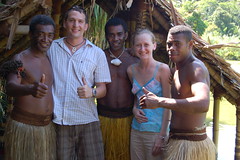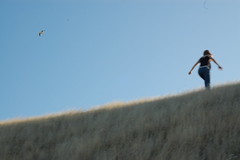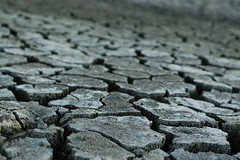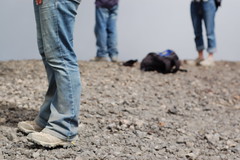Signing in from Melbourne....
If you checked our photo gallery recently, you know that we are alive and weren't swallowed by a hungry
croc or died of thirst in the burning outback. No, Ryan and I are alive and well, very well, indeed, it's just that we've had absolutely no time to write an update on our Australian adventure - we haven't been around computers much in the last 12 days. In fact, we haven't even been around much civilization in the last 12 days!
Excluding the last two days, which we already spent back in the civilized world where people, fuel and water can be found in every few miles, instead of every few
hundred miles, we've spent the last two weeks crossing the vast and forbidding Australian outback. Overall, we've been very busy since we arrived in this country on May 1 - we've crossed 4 of Australia's 6 states and one of its 2 territories, visited 4 of Australia's 5 major cities, drove on average over 500km a day and saw the most cosmopolitan, as well as the most remote and desolate regions of this crazy country.
And with all this, we haven't even started to scratch the surface of all that this country has to offer! Australia is an amazing country! A truly amazing, fascinating place filled with sunshine, friendly people, weird-looking animals and plants, mind-boggling natural landscapes and vibrant cities that will blow your socks off! It's just like another planet - you arrive here from the pastoral, temperate-climate New Zealand that looks much like Ireland or Austria with its pine forests and steep mountains, and then you're here - on an unbelievably flat continent with ghostly skeletal gum trees (the ever-present eucalyptus), red earth, strange birds and weather-worn people in bush hats and you almost can't believe you're on the same planet! And you though that you're practically just next door to New Zealand...
So here's my meager attempt to summarize what we've done and seen since we arrived in Sydney on May 1:
Sydney - we loved it!
We had no expectations of Australia, so everything came as a surprise to us here. But I knew I was going to like Australia as soon as we got off the plane in Sydney and walked through the airport's arrival terminal that had walls plastered in life-size photos of scenes from "the bush" - with objects helpfully named in their exotic Aussie outback slang, like
dunny,
Sheila,
esky,
swag and
swagman...
We heard about the Sydney-Melbourne rivalry months before we even set foot in Australia. (If you happen to meet an Australian who's partial to one of these two cities, one of the first things she will tell you about Australia is how crap the other city is. Sydney is boring and business-like, Melbourne is funky and all about culture...etc.) So we heard that Sydney is the commercial city, while Melbourne is the culture city, and we expected Sydney to be a concrete jungle overrun with business suits and traffic jams - just the typical, anonymous, overcrowded and polluted city. But it was none of that!
Already on our way from the airport on a shuttle, we saw that Sydney was filled with lots of quaint and quiet neighborhoods with distinctly local atmosphere and establishments. We checked in to a hostel in one of those quaint neighborhoods called King's Cross and one of the very first things we saw when we walked out of the hostel on our way to the city was a pair of parrots feeding on some bush flowers. Wild parrots right in the middle of a city that were so unafraid that you could almost touch them! Amazing. We instantly knew we liked Sydney.
After that, the city got only better - we walked through the Royal Botanic Gardens and were amazed to see more wild parrots, fruit bats and ibises and other interesting-looking creatures just walking around, while people were relaxing on the impeccable lawns and elegant skyscrapers were silently looming over the scene in the background. And then we got to the opera and it was such a
pinch-me-am-I-dreaming? kind of moment that it took us a few hours and a lot of staring to finally believe that we were in Sydney. The opera is magnificent - a truly spectacular building that deserves all the fame it gets and we stared at it for a
looong time. And then we walked passed it and the view that opened up was even more spectacular - the massive Sydney Harbour Bridge hung over the large bay with sun setting behind it and to our right the skyscraper skyline was gleaming and ferries and tugboats were zooming by in the water - and the whole scene was so serene and relaxing! None of the busy crowds and loud traffic that we were expecting.
The thing about Sydney is that it's not on the way to anywhere else. If you end up in Sydney, it's because you spent a lot of time and money to be there. You were not on your way to Paris, it wasn't a short drive from your grandma's - it's so far away that you have to produce a fair amount of effort to get there, so when you're finally there it's just sort of unbelievable. You're in Australia, in Sydney, you're looking at one of the most famous and iconic structures in the world - and you can't believe you made it! Anyway, Sydney is great. The city has class and elegance; it has gorgeous beaches, fine dining, the bridge, the opera, wild parrots and, contrary to expectations, really nice locals. It's, in my opinion, one of the great cities of the world - no matter what
Melbournites might say.
The next day we rented our van, slept in it on the street in King's Cross, and took off from the city the following day. We were heading up north to Queensland's Gold Coast to visit my old friend Alica. It took us two fairly uninteresting days of driving to get to Gold Coast - the Florida of Australia. Gold Coast is a long stretch of a magnificent beach surrounded by chrome-and-glass development of high-rise hotels, beach resorts and first-class shopping. The weather was getting progressively warmer as we headed further north and, after two months of freezing in New Zealand, we shed our socks, shoes, long-sleeved shirts and long pants - and were in the summertime again!
We met up with Alica and her boyfriend Alex and spent a night with them. I was overjoyed to see my old friend. She and I took our very first flight to the US together 12 years ago, when we were headed for our one year at New Jersey prep schools. We hit it off during that scholarship program, but we haven't seen each other for 10 years! So we had a lot to catch up on and I was so excited that I didn't notice how much cheap wine I drank. Not surprisingly, I was suffering quite heavily the next day, while Ryan and Alex took a board and went surfing at the nearby beach. After I recovered enough to leave the toilet alone, we took off for
Nimbin - a place Alex and Alica told us about.
Nimbin is a self-declared marijuana capital of Australia and every year the town organizes a festival called
Mardi Grass - it was the last day of this festival that we were going to catch that Sunday night.
Nimbin was fun, as you can imagine (you know who you are!) - hippies of all ages in all stages of intoxication were strolling down the colorfully painted main street that was lively with concerts, movie projections and other peaceful and loving activities... We stayed overnight, bought souvenirs the next morning and backtracked to Gold Coast to say good-bye to Alica and Alex and to head north to Brisbane.
The subtropical capital of Queensland, Brisbane, was our gateway to the outback. After talking to Alex and Alica, we decided that despite paying an astronomical amount for fuel, we were going to drive to
Uluru - the mighty red rock in the middle of the continent. It was our original plan for Australia, then we thought it's simply too ambitious a plan, but then Alex persuaded us that we should not miss out on such an opportunity. After all, we had a van that we could comfortably sleep and cook in and we had 3 weeks to do the drive, so
when's a better time to undergo this sort of adventure? So we decided we would drive the 8,000km from Brisbane to Sydney via Alice Springs, Adelaide, Melbourne and Canberra. Why the hell not?
After checking out Brisbane - another ultramodern, sleek and elegant city full of street art (and even a man-made beach right in the city center!) - we took off for the inland. For a day and a half we were crossing little townships and miles and miles of cattle stations. We were in "the bush" - the section of Australia that separates the urban east coast from the "outback" - the real Australian wilderness that not even many Australians visit. On this initial stretch of highway, we started to see loads and loads of roadkill - hundreds upon hundreds of dead kangaroos lined the highway in the most gruesome contortions. At least we finally saw that Australians didn't make up those kangaroos - there were really out there, just not alive. I started craning my neck to spot some live ones, but I must sadly report, that during our 12 days in the outback, we spotted only 5 live kangaroos near the road. (We were slightly more lucky with emus and eagles.) Disappointing, indeed. If I had one definite expectation of Australia it was taking a photo of a group of kangaroos gently hopping into a desert sunset. No such luck. With the kangaroos, not the sunset, that is. The sunset we saw every night - and every night the sunset over the endless plains was stunning - an explosion of pink and lavender colors, illuminating the whole horizon with the most subtle and beautiful colors you could ever imagine.
So within a day and half of driving, we were finally in the outback. Vegetation grew sparse, as well as human settlements and anything else. We left towns, villages and big trees behind and were in the land of scrubs, lonely gums, herds of cattle and fuel on every 200km. We measured our driving by the distant outback towns, in each of which we had to get the precious fuel. Fuel is a life-giving liquid out there - you never want to run out of fuel in the outback. Even though we were driving on the one paved highway that is relatively busy with passing
campervans and trucks (you pass a few every hour), we would have been in a very dire situation had we run out of fuel out there. The massive road trains - trucks that pull as many as four trailers over massive distances in the outback - cannot easily stop for stranded tourists. And what if there were no other tourists passing by for hours? Or days? Lucky for us, it is autumn now and the outback is warm, bordering on hot during the day and pleasantly cool at night, but in the summertime it gets lethally hot. Murderously hot. If people don't get rescued in a few days, they die of thirst and heat exhaustion. So, we made sure we always had enough fuel and water in our tanks
just in case.
It took us 6 days of dedicated driving to get to Alice Springs, the famous outback town that is located smack in the middle of the country. We passed about a dozen little outback towns that are nothing more than a collection of a few houses surrounding a
roadhouse - a place with fuel, food,
campervan park and a bar. Sometimes the dot on the map wasn't even a town, but only the roadhouse that offers petrol, very simple accommodation and a selection beef pies. The scenery changed every day - we passed scrubby and bushy plains, plains covered lushly with
spinifex (the maliciously prickly grass), plains dotted with thousands of red termite mounds the size of small children, trees and scrubs again...and all this time the land around us was impossibly flat as far as eye could see...
We heeded the oft-repeated advice not to drive during dusk (that's when the
roos come out of the plains onto the roads and cause accidents - or more often just their own tragic end), so every evening right before sunset we pulled up to a roadside rest stop for the night. Normally, we would have a view of a gorgeous sunset from one side of the car, and then in the morning we'd have a view of a gorgeous sunrise on the other. It beats waking up in a wet, cold tent, that's for sure! The only thing that was missing were those kangaroos hopping gently on the horizon...
A lot of people believe that once you're in Alice Springs, you're next to
Uluru, but that's far from the truth -
Uluru is another day's drive from the town, so after
flying across the world to Australia and then driving
across a whole continent to Alice Springs, you find out that you still have to drive almost all day to get to this big red rock! You have to be really determined to get to see this damn rock, and maybe that's why you're in such awe when you finally see it. It's a rock like no other.
We got there just before sunset, but it was cloudy, and without
sun rays the rock just faded into darkness without its famous explosion of red color. Unfazed by this misfortune, we left the park, camped out on the side of the road and returned for sunrise the next morning - and it was perfect! We were staring at the rock with about a hundred of other tourists (most of whom were wheeled off by their "off-the-beaten-path" luxury adventure tour couches before the
sun rays even touched the rock !) and then - now with the tourists gone, in the serene stillness of the desert, the sun came over
the clouds and the rock was
on fire. Now, this amazing view was well worth the travel
across the world! Next to the rock, the Kata
Tjuta National Park also has an amazing cultural center that explains all about the spiritual meaning of
Uluru to the local
Aborigines, but we couldn't take pictures, so we can tell you that what we learned there, in a nutshell, is that
Uluru is a very sacred and spiritual place.
After
Uluru, we hurried back to civilization through a few more thousand miles of the ever-changing desert. One stop that is worth mentioning was the mining town of
Coober Pedy -
the opal capital of the world. For miles before entering the town, we drove through stretches of the most desolate and arid landscape that was dotted as far as eye could see with thousands of conical mounds - the opal mine shafts. Then we entered the town and learned all about these shafts, opal mining, opal and about just how unique this place is.
Coober Pedy is a town without grass, every other shop on the main street sells precious opal and half of the town's 3500 residents live in
dugouts - large underground homes that retain a year-round comfortable temperature of 24 degrees
Celsius - even in the worst heat of the summer. I would definitely call this "extreme living." But, many people have found their fortunes here, as opal is plentiful, profitable, and you only need to get a $50 license to start digging.
Once we finally reached the populated area of the south coast, we checked out Adelaide, the capital of South Australia (albeit briefly because we wasted over 2 hours of our time watching the worst movie of the decade -
Spiderman 3!) and continued to a city that we definitely wanted to see more closely - Melbourne, the capital of Victoria.
So how does Melbourne fare in the rivalry match with Sydney? Well, I can see what
Melbournites mean when they say that Sydney is all business and no fun: compared to Melbourne, Sydney does seem a little culturally impoverished... Melbourne is a city of theaters and movies, art and culture, that's obvious as soon as you get to downtown. Plays and musicals are advertised everywhere, every street is adorned with street art, buildings are funky and unique...the whole city seems to thrive on creativity. We happened to be in town for Buddha's birthday festival, so we got some
Asian food, watched
Asian cultural performances and, since it was bitter cold and the weather was no good for good pictures, we splurged on a trip to the observation deck of the
Rialto Tower, the tallest tower in the southern hemisphere, for a sunset view over the city. That made up for the crappy weather quite well - and chocolate cake from
the cafe was amazing, too!
Unfortunately, we could not stay in Melbourne for long, so we took off the next afternoon and headed for
the nation's capital, Canberra, about 700km north of Melbourne. We got to Canberra
the following day - and by this time we were probably already a little travel-tired - so we kind of blew Canberra. But who cares about Canberra anyway? It's amazing that we even made the
effort to get there because no one goes to
Canberra. No one who doesn't have to, anyway. In a country that likes to announce distant cities with road signs like
Darwin -3,355km, Canberra wasn't announced on one of the highways that lead to it until 200km before it! We saw signs for Sydney for a day before we saw one for the capital! That shows how much Australians care about Canberra - and when we got there we knew why. It's one of those
pre-planned, widely spread out, official-looking and socially dead government cities that were always meant to entertain only government workers, lawyers and lobbyists. Kind of like DC. (What a nasty flashback!) But, no, Canberra isn't that bad, I'm sure, it was just - rather empty and quiet. We visited the national gallery and then decided that we don't really care about seeing
Canberra anymore, so we took off - there was only one more thing that we had to see while in Australia...
Kangaroos! We had to see live kangaroos! So we headed back for Sydney to visit a wildlife park, so that we could finally see and touch all the weird Australian animals that were so elusive during our 12-day drive through the interior. So we did it this morning and had more fun than little children on a school trip. It was amazing! We got to pet kangaroos who just hopped around all over the place, we petted a koala, got close to wombats, cassowaries, Tasmanian devil, dingos and untold number of parrots and peacocks and all sorts of other creatures. Just wait for the pictures - they're great! We're happy we have the pictures at all because shortly after the wildlife park, our camera was stolen out of the van! But Ryan bravely chased down the scumbag and, with the help of local policemen, went to the junkie's putrid hideout a few blocks down and retrieved the camera. So, after a few moments of very high stress, we got our precious pictures back. Uff!!!
Gotta go. It's late and tomorrow early we fly to Thailand for 2 weeks. What a trip this has been!







